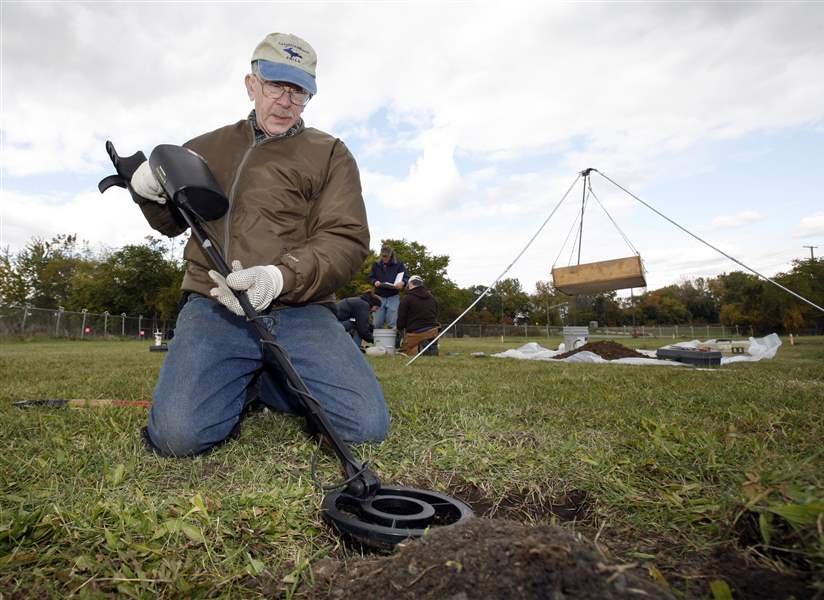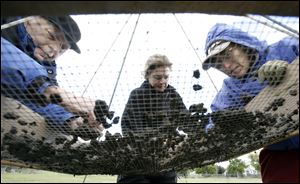
Sifting through River Raisin history; dig yields little from 1813 battle
10/18/2009
Volunteer Dan Drzewiecki surveys a section of soil during the archaeological dig to find artifacts. The battle was a catastrophic defeat for American forces during the War of 1812.
The Blade/Andy Morrison
Buy This Image

Andy Arnoldy, left, Allison Hoff, and Laurel Heyman sift through excavated soil near the River Raisin battlefield in Monroe.
MONROE - Archaeologist G. Michael Pratt and his crew have been working hard this chilly weekend.
But so far, his latest effort at finding artifacts from the 1813 Battle of the River Raisin has turned up nothing of historical value.
Mr. Pratt, a Heidelberg University anthropology professor and associate vice president for academic affairs, has been focusing on areas peripheral to the battlefield. Those are on the north bank of the Raisin, a quarter-mile west of I-75.
He hopes that finding remnants from the battle, a catastrophic defeat and massacre of American forces during the War of 1812, will give insight into the armed conflict itself and the people who participated in it.
Musket balls, metal buttons from military uniforms, and other artifacts have been unearthed in archaeological digs on the battlefield, which has been identified for development into a national park.

Volunteer Dan Drzewiecki surveys a section of soil during the archaeological dig to find artifacts. The battle was a catastrophic defeat for American forces during the War of 1812.
Saturday, Mr. Pratt and 15 volunteers were digging in a 150-square-meter plot south of the Raisin on East First Street east of Eastchester Street.
The area would have been di-rectly in the path the Americans took in retreating across the river to escape the British army and its Indian allies. Only 33 of more than 900 Americans survived. The huge loss of life gave rise to the War of 1812 rallying cry, "Remember the Raisin!"
The problem for Mr. Pratt is that the peripheral areas have been developed over the years and covered with fill. Even the untrained eye can easily distinguish layers of added soil in the neat, rectangular test pits the archeologist's assistants dig.
"There are more than 16 inches of fill here," Mr. Pratt explained, as he stood over one of the test pits. That puts many artifacts beyond the range of his metal detectors.
The situation was much the same earlier, when Mr. Pratt explored the soil at Plum Creek Park and a site along Plum Creek. But not all digs are so frustrating.
One of the volunteers is Monroe resident Laurel Heyman, who is president of the Michigan Archaeological Society and a veteran of many digs.
She recalled Mr. Pratt's excavations at the battlefield in 2003 that unearthed musket balls and a trigger guard from a musket. Those are now part of the collection at the Monroe County Historical Museum, she said.
In 1995, Mr. Pratt gained a measure of fame for finding the true location of the Fallen Timbers battlefield in Maumee by discovering hundreds of artifacts. He has also performed a dig on Mackinac Island, Mich.
He noted that both of those excavations were in land that was undisturbed compared to the peripheral Battle of the River Raisin sites. The Fallen Timbers remnants were preserved in farmland, while the Mackinac Island artifacts were in a golf course.
Mr. Pratt's study is financed by a $28,674 grant from the American Battlefield Protection Program.
Mr. Pratt also is director of Heidelberg's Center for Historic and Military Archeology.
Today, he is slated to be at a site north of the battlefield. "That's another area that, if it's not highly disturbed, we should be able to find artifacts there," he said.
Contact Carl Ryan at:
carlryan@theblade,com
or 419-724-6050.